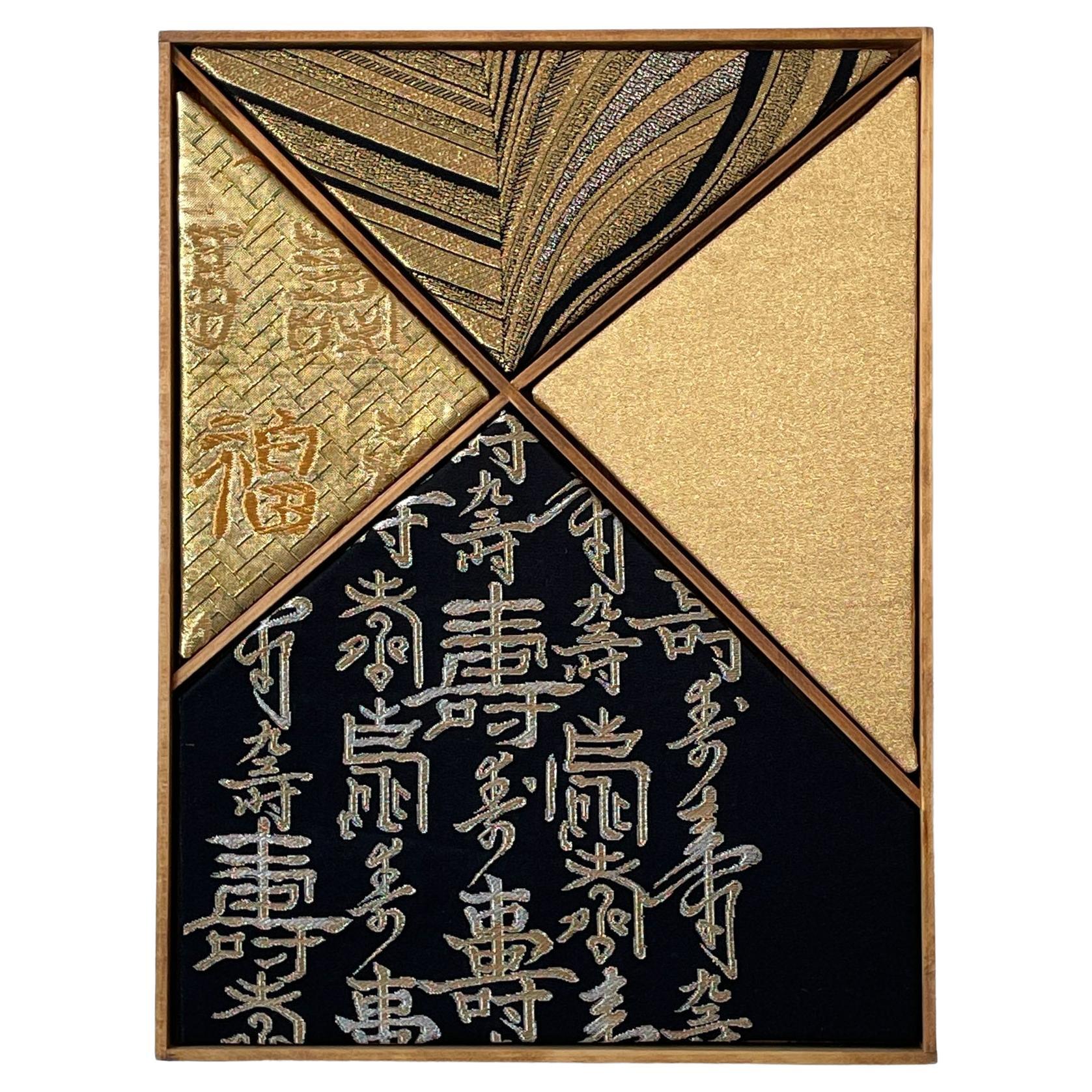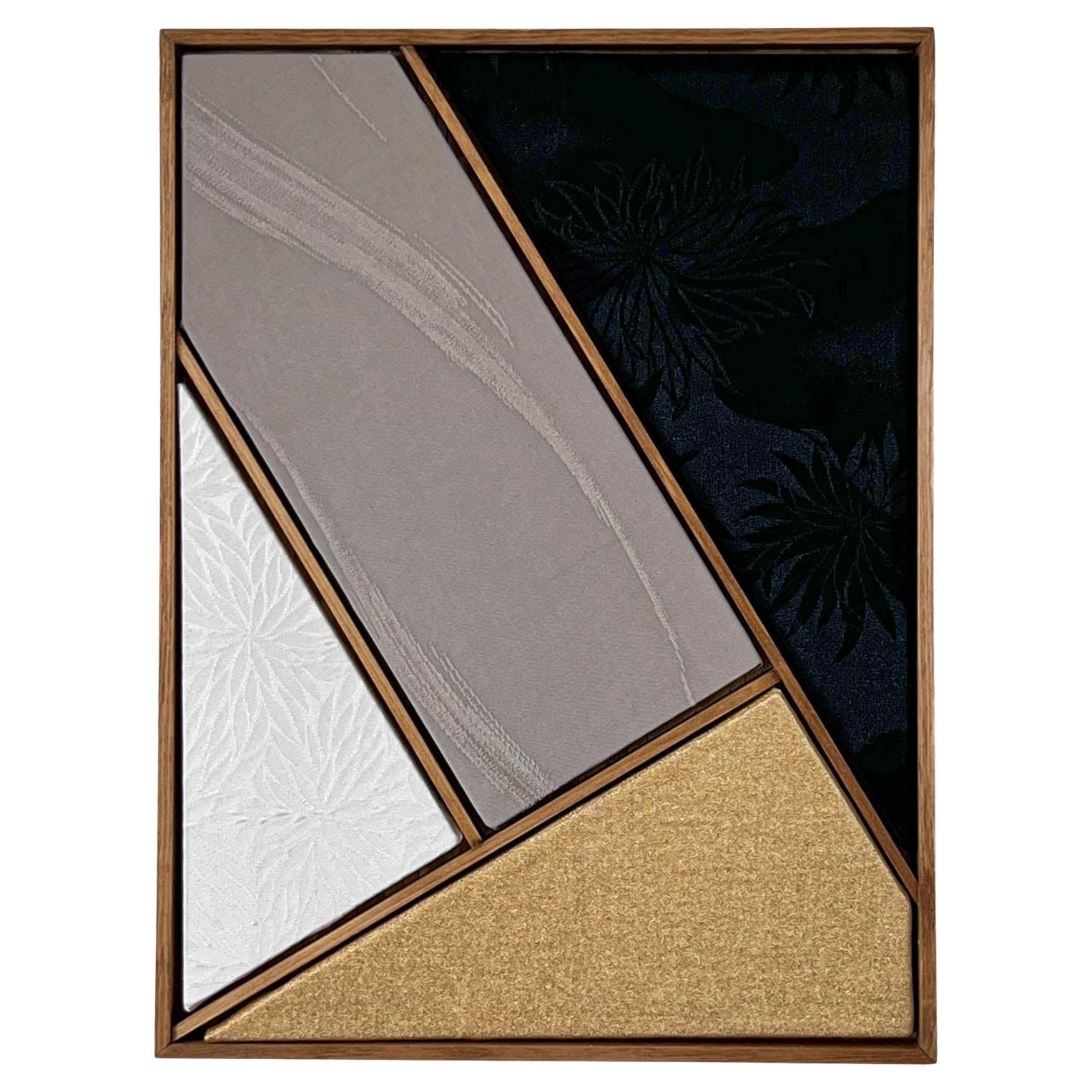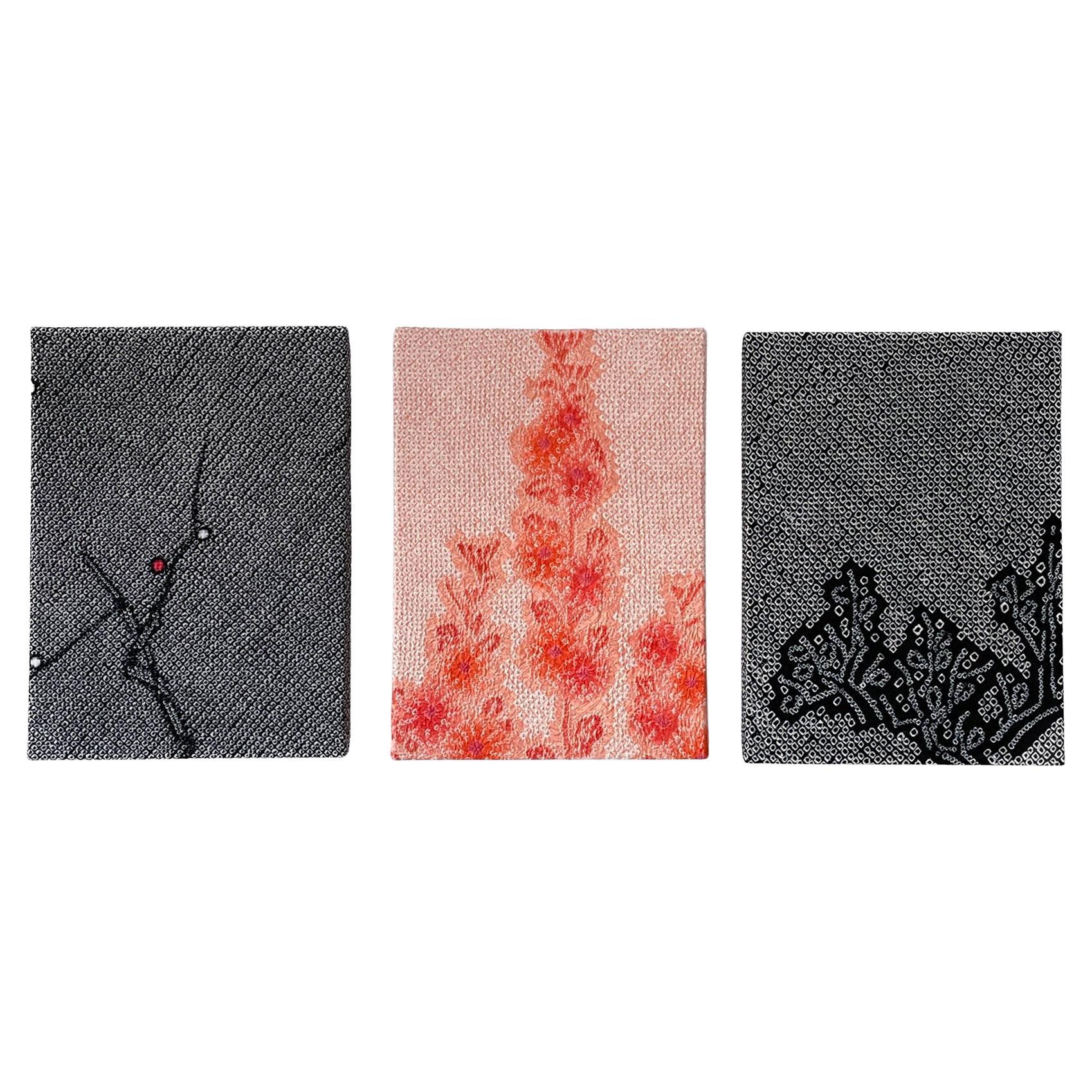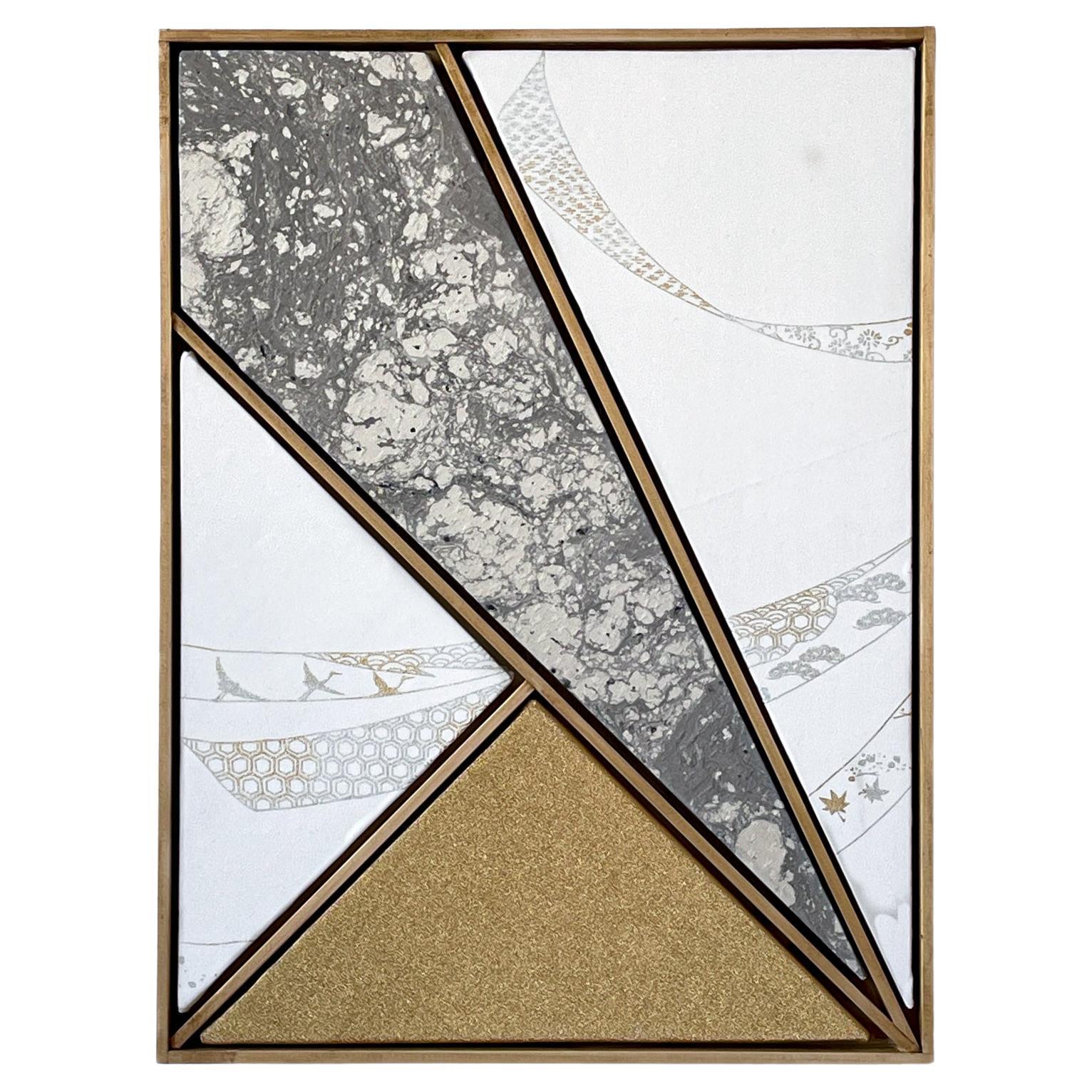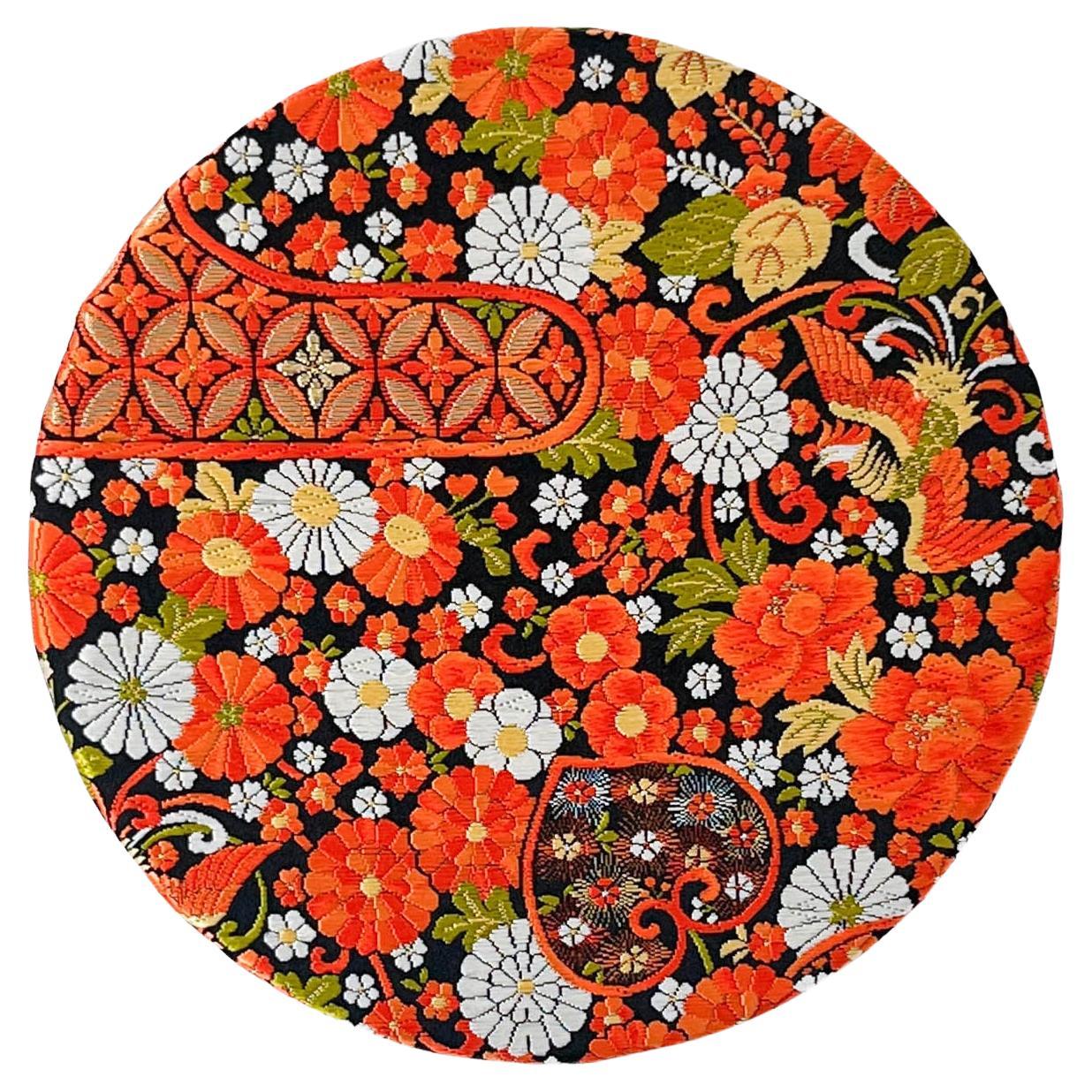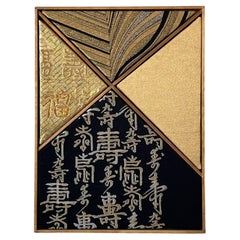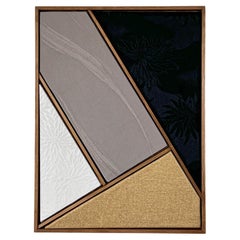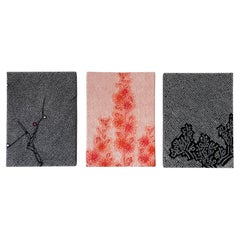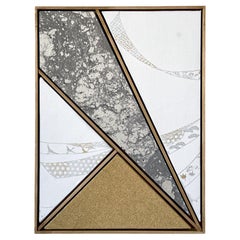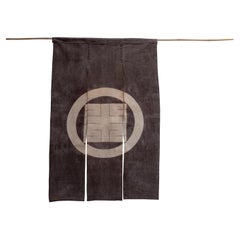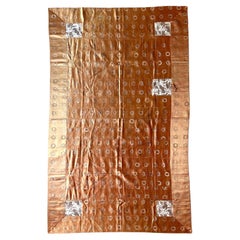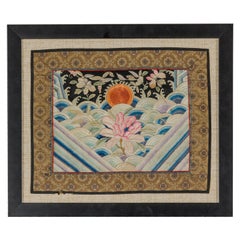Items Similar to Vintage obi textile art " Moon phase II " by ikasu Silver, Black, Japan
Want more images or videos?
Request additional images or videos from the seller
1 of 10
Vintage obi textile art " Moon phase II " by ikasu Silver, Black, Japan
$490
£374.63
€431.50
CA$686.64
A$766.57
CHF 401.67
MX$9,383.56
NOK 5,101.22
SEK 4,809.81
DKK 3,220.32
Shipping
Retrieving quote...The 1stDibs Promise:
Authenticity Guarantee,
Money-Back Guarantee,
24-Hour Cancellation
About the Item
<< About this artwork >>
This artwork has been upcycled from a stunning obi, which is adorned with calligraphy weaving saying "moon" and "moonlight".
<< Period / Story >>
The obi used in creating this canvas was originally made and used during the late Showa period (around 1970ies).
<< Explanation and meaning of pattern and colors >>
In Japanese culture, the moon holds significant symbolic meanings and is often featured in various forms of art, including kimono patterns. Here are some interpretations of the moon pattern on a kimono:
Beauty and Elegance: The moon is often associated with beauty, elegance, and grace. Its soft, luminous glow has inspired poets, artists, and storytellers for centuries. A moon pattern on a kimono can evoke a sense of ethereal beauty and timeless elegance, enhancing the overall aesthetic appeal of the garment.
Femininity: In Japanese culture, the moon is sometimes associated with femininity and the goddess archetype. It is often depicted as a gentle, nurturing presence, symbolizing maternal love and intuition. A moon pattern on a kimono may therefore convey qualities of femininity, nurturing, and emotional depth.
Transience and Impermanence: The moon's cyclical phases, from new moon to full moon and back again, symbolize the passage of time and the transient nature of life. In Japanese philosophy, this concept is known as "mono no aware," or the awareness of impermanence. A moon pattern on a kimono can serve as a reminder to cherish the present moment and appreciate the beauty of fleeting experiences.
Harvest and Festivals: In traditional Japanese culture, the moon plays a central role in harvest festivals and lunar celebrations, such as Tsukimi (the moon-viewing festival) and Otsukimi (the harvest moon festival). These festivals are held to give thanks for the harvest and to celebrate the beauty of the moon. A moon pattern on a kimono may therefore symbolize abundance, gratitude, and the rhythms of nature.
Overall, the moon pattern on a kimono carries rich symbolic meanings, representing beauty, femininity, transience, and cultural traditions. It adds depth and significance to the design of the garment, reflecting the wearer's appreciation for nature, aesthetics, and the poetic symbolism of the moon.
- Creator:Kimono ikasu (Artist)
- Dimensions:Height: 0.79 in (2 cm)Diameter: 13 in (33 cm)
- Style:Japonisme (In the Style Of)
- Materials and Techniques:
- Place of Origin:
- Period:
- Date of Manufacture:1970ies
- Condition:
- Seller Location:Setagaya City, JP
- Reference Number:1stDibs: LU10079243698582
About the Seller
No Reviews Yet
Vetted Professional Seller
Every seller passes strict standards for authenticity and reliability
1stDibs seller since 2024
- ShippingRetrieving quote...Shipping from: Setagaya City, Japan
- Return Policy
Authenticity Guarantee
In the unlikely event there’s an issue with an item’s authenticity, contact us within 1 year for a full refund. DetailsMoney-Back Guarantee
If your item is not as described, is damaged in transit, or does not arrive, contact us within 7 days for a full refund. Details24-Hour Cancellation
You have a 24-hour grace period in which to reconsider your purchase, with no questions asked.Vetted Professional Sellers
Our world-class sellers must adhere to strict standards for service and quality, maintaining the integrity of our listings.Price-Match Guarantee
If you find that a seller listed the same item for a lower price elsewhere, we’ll match it.Trusted Global Delivery
Our best-in-class carrier network provides specialized shipping options worldwide, including custom delivery.More From This Seller
View AllVIntage kimono textile art " Wish for prosperity " by ikasu Gold, Black, Japan
By Kimono ikasu
Located in Setagaya City, JP
This work is inspired by traditional Japanese nature colors symbolism, and is framed in paulownia wood originally used for a kimono chest-of-drawers.
It is filled with storytelling ...
Category
Vintage 1960s Japanese Japonisme Paintings and Screens
Materials
Silk, Wood
VIntage kimono textile art " Monochrome Geometry " by ikasu Gold, Grey, Japan
By Kimono ikasu
Located in Setagaya City, JP
This work is inspired by traditional Japanese nature colors symbolism, and is framed in paulownia wood originally used for a kimono chest-of-drawers.
It is filled with storytelling ...
Category
Vintage 1960s Japanese Japonisme Paintings and Screens
Materials
Silk, Wood
Vintage kimono textile art "Flowers ~Life Circle~" by ikasu Pink, Black, Japan
By Kimono ikasu
Located in Setagaya City, JP
<< About this canvas >>
This canvas is crafted from three different haori fabrics, each adorned with a shibori dyeing flower motif going through entire fabric. These fabrics tell a ...
Category
Vintage 1970s Japanese Japonisme Paintings and Screens
Materials
Canvas, Silk
VIntage kimono textile art "Geometry ~Marble~" by ikasu Gold, White, Grey, Japan
By Kimono ikasu
Located in Setagaya City, JP
This work is inspired by traditional Japanese nature motifs symbolism, and is framed in paulownia wood originally used for a kimono chest-of-drawers.
It is elegantly framed with pau...
Category
Vintage 1960s Japanese Japonisme Paintings and Screens
Materials
Silk, Wood
Vintage kimono textile art "Marble Story ~ Healing ~" by ikasu Grey, Japan
By Kimono ikasu
Located in Setagaya City, JP
This work uses a vintage kimono fabric with marble pattern, that makes it look like a real piece of marble.
The line in the middle symbolizes “kintsugi” - concept of wabi-sabi, which values imperfection, impermanence, and the beauty of aging.
It is elegantly framed with paulownia wood originally used for kimono chest-of-drawers, and is filled with storytelling and sense of luxury.
I used pieces of kimono that could no longer be used as clothing and kiritansu chest-of-drawers that would normally be discarded to create the ultimate upcycled piece.
<< Explanation and meaning of pattern and colors >>
Kintsugi (金継ぎ), which translates to "golden joinery" or "golden repair," is a traditional Japanese art form of repairing broken pottery with lacquer mixed with powdered gold, silver, or platinum. I used this tecnique here to "repair" antique kimono by transforming it into art work. Beyond its literal meaning of mending broken ceramics, kintsugi carries profound philosophical and cultural significance in Japanese tradition:
・Embracing Imperfection: Kintsugi celebrates imperfection and impermanence. Rather than disguising or concealing flaws, it highlights them, treating the breakage as part of the object's history. This philosophy encourages acceptance of imperfection as an essential aspect of life, beauty, and human experience.
・Wabi-Sabi Aesthetic: Kintsugi embodies the principles of wabi-sabi, an aesthetic worldview centered on the acceptance of transience and imperfection. Wabi-sabi values simplicity, authenticity, and the beauty of things that are imperfect, impermanent, and incomplete. Kintsugi exemplifies these principles by turning what might be considered flaws into features that enhance the object's beauty and character.
・Resilience and Transformation: The act of repairing broken things with precious metals symbolizes resilience and transformation. Instead of discarding or replacing the broken object, kintsugi honors its history and transforms it into something new and valuable. This reflects broader philosophical themes of overcoming adversity, finding beauty in imperfection, and embracing change.
・Honoring the Past: Kintsugi preserves and honors the history of the object. Rather than erasing or ignoring its past, it acknowledges and celebrates it. This aspect of kintsugi can be seen as a metaphor for honoring our own personal histories, including the challenges and setbacks we have faced, and recognizing how they have shaped us into who we are today.
・Spiritual and Philosophical Symbolism: Kintsugi has spiritual and philosophical implications, reflecting concepts such as the interconnectedness of all things, the cycle of life and death, and the pursuit of harmony and balance. The process of repairing broken objects with precious metals is seen as a metaphor for spiritual growth, enlightenment, and the journey towards wholeness.
Overall, kintsugi represents not only a practical technique for repairing ceramics but also a profound philosophical and cultural perspective on life, beauty, and the human experience. It embodies values such as resilience, acceptance, and the transformative power of embracing imperfection.
<< Characteristics of the fabric >>
This vintage textile is hand-painted with a traditional painting technique where the colors are added on wet surface, which creates an effect of marble.
<< About the frame >>
Kiritansu - chest-of-drawers for kimono, is traditionally made from paulownia wood, a uniquely Japanese material closely tied to the world of kimonos.
Paulownia wood is known as the lightest wood in Japan, prased for its natural luster, resistance to moisture, and resilience against cracking. Since ancient times, it has been used in crafting furniture, chests, and musical instruments.
During the Edo period, it became customary to store cherished kimonos in paulownia chests...
Category
Vintage 1960s Japanese Japonisme Paintings and Screens
Materials
Gold Leaf
Vintage obi textile art "Sacred Geometry ~Longevity~" by ikasu Orange, Japan
By Kimono ikasu
Located in Setagaya City, JP
About This Canvas
This unique canvas has been meticulously upcycled from a vintage obi—a traditional Japanese sash—entirely adorned with auspicious motifs and richly detailed floral ...
Category
Vintage 1970s Japanese Japonisme Decorative Art
Materials
Canvas, Silk
You May Also Like
Fabric Divider, Cotton Noren with Kakumoji Character, Japan, Early 20th Century
Located in Tokyo, Tokyo
This is a traditional Japanese noren (fabric shop curtain) dating to the Taisho period (1912–1926), crafted from cotton dyed with persimmon tannin (kakishibu). Over time, the dye has...
Category
Early 20th Century Japanese Textiles
Materials
Cotton
Vintage Japanese Indigo Folk Kamon Textile
Located in Chicago, IL
Dating to the mid-20th century, this vintage Japanese textile is a folk example of traditional stencil dyed fabric, known as katazome. Richly...
Category
Mid-20th Century Japanese Textiles
Materials
Cotton
Antique Japanese Embroidered Silk Kesa Monk's Robe Edo Period
Located in Atlanta, GA
A Japanese Kesa (Monk's Vestment) made from thirteen columns of patchworks of fine shimmering silk fabric of a salmon orange color, the shade of which changed subtly from different a...
Category
Antique 19th Century Japanese Edo Textiles
Materials
Brocade, Silk
Vintage Chinese Silk Fabric with Flower and Sun Motif in Custom Black Frame
Located in Yonkers, NY
A vintage Chinese silk fabric depicting pink flowers, waves and the sun set in a black custom made frame, under glass. This vintage Chinese...
Category
Mid-20th Century Chinese Decorative Art
Materials
Silk, Glass, Wood
Japanese Monastery Robe Patchwork Kesa with inscription Edo Period
Located in Atlanta, GA
A Japanese Kesa (Monk's Vestment) made from fourteen columns of patchworks of blue brocades with sumptuous woven pattern. The elaborate motifs feature re...
Category
Antique Early 19th Century Japanese Japonisme Textiles
Materials
Brocade, Silk
Framed Japanese Embroidery Textile Panel Meiji Period
Located in Atlanta, GA
A Japanese textile panel with embroidered picture work circa late Meiji period (1900s) presented in a gilt wood frame with silk mat. The work de...
Category
Antique Early 1900s Japanese Meiji Textiles
Materials
Silk, Wood
More Ways To Browse
Vintage Textile Art
Japanese Used Kimono
Japanese Weaving
Japanese Silver Leaf
Black Kimono
Upcycle Art
Vintage Kimonos
Phases Of The Moon
Vintage Silk Screens
Black Vintage Kimono
Asian Goddess
Kimono Obi
Japanese Screens Showa Period
Calligraphy
Japanese Screen Kimono
Japanese Calligraphy Screen
Japanese Silver Leaf Screen
Vintage Japanese Obi
